Influence of Engine Oils on Pre-Ignition Tendency in a Hydrogen–Kerosene Dual-Fuel Engine
Abstract
1. Introduction
1.1. Abnormal Combustion in H2-ICEs
1.2. The Role of Lubricants in H2 Combustion Engines
- Throw-Off: Inertia forces of the piston propel oil droplets into the combustion chamber
- Reverse Blow-By: Gases carrying oil bypass the upper compression ring and enter the cylinder, either through the ring gap or via the ring groove
- Evaporation: Evaporation of oil due to heated surfaces
- Top Land Scraping: The piston’s top land, or the carbon deposits that typically accumulate on this surface, physically remove oil from the liner.
1.3. Particle-Induced Pre-Ignitions
2. Methodology
2.1. Engine Test Bench Setup
| Hydrogen energy share | [-] | |
| Hydrogen mass flow | [kg/h] | |
| Lower heating value of hydrogen | [MJ/kg] | |
| Kerosene mass flow | [kg/h] | |
| Lower heating value of kerosene | [MJ/kg] |
2.2. Tested Oil Candidates
2.3. Flushing Procedure
2.4. Pre-Ignition Detection
| Peak pressure limit for PI detection | [MPa] | |
| Mean value of peak pressures | [MPa] | |
| Standard deviation of peak pressures | [MPa] |
2.5. Test Procedure
- Addition of a high-load phase (Phase II) to remove deposits in the combustion chamber prior to the measurement phase (Phase III);
- Lean kerosene operation during Phase I and Phase II (, resulting in );
- Water injection during the first ten minutes of Phase II to remove particles and deposits in the intake ports and on the intake valves;
- Full opening of the exhaust pressure valve in all phases to reduce internal exhaust gas recirculation (EGR), which contributes to increased soot formation;
- High H2 energy share (70%) in Phase III to minimize soot formation during measurement ().
3. Results
3.1. Flushing Efficiency
3.2. Oil
3.3. Particles and Deposits
4. Conclusions and Outlook
- By using a test procedure specifically developed for the dual-fuel hydrogen–kerosene engine, pre-ignition events were detected with high accuracy.
- A detailed purging procedure ensured that contamination between the test oils was minimized, allowing the cross-influences of other oils to be effectively neglected.
- The investigation of oils with varying detergent contents (calcium and magnesium) revealed that these components had no significant influence on the tendency for pre-ignition.
- However, it was demonstrated that increasing the molybdenum content significantly reduced the number of pre-ignitions. In fact, the pre-ignition events decreased from 13 with the reference oil, without a molybdenum content, to 4 with 38 ppm of molybdenum (Candidate 4), and to just 1.5 with 480 ppm of molybdenum (Candidate 5).
- Further investigations into particle-induced pre-ignition, attributed to the unavoidable soot formation in the dual-fuel combustion process, showed that approximately 85% of the pre-ignitions were caused by particles, with only 15% resulting from the oil. This ratio is likely similar in regular dual-fuel hydrogen operation. A comparative measurement with the test oil that exhibited the lowest pre-ignition rate due to its molybdenum content (Candidate 5) showed that the number of pre-ignitions with particle loading could only be slightly reduced.
Author Contributions
Funding
Data Availability Statement
Acknowledgments
Conflicts of Interest
Abbreviations
| CAD | Computer-aided design |
| CCS | Cold-cranking simulator |
| CO2 | Carbon dioxide |
| Ca | Calcium |
| CaO | Calcium oxide |
| DI | Direct injection |
| EGR | Exhaust gas recirculation |
| FSN | Filter smoke number |
| g/g | Gram per gram |
| HEFA | Hydroprocessed ester and fatty acid |
| H2 | Hydrogen |
| ICE | Internal combustion engine |
| IFA | Institut für Fahrzeugantriebe und Automobiltechnik, engl.: Institute of Powertrain and Automotive Technology |
| IMEP | Indicated mean effective pressure |
| KV | Kinematic viscosity |
| LHV | Lower heating value |
| Mg | Magnesium |
| MPa | Megapascal |
| MoDTC | Molybdenum dithiocarbamate |
| PAH | Polycyclic aromatic hydrocarbon |
| PFI | Port fuel injection |
| PI | Pre-ignition |
| RPM | Revolutions per minute |
| SA | Sulfate ash |
| SAF | Sustainable aviation fuel |
| TBN | Total base number |
| VI | Viscosity index |
| W/W | Watt per watt |
| λ | Air–fuel ratio |
References
- International Council on Clean Transportation. Vision 2050: A strategy to decarbonize the global transport sector by mid-century. White Paper, 21 September 2020; p. 5.
- Reitmayr, C.; Wiesmann, F.; Gotthard, T.; Hofmann, P. Experimental and Numerical Investigations of a Dual Fuel Hydrogen-Kerosene Engine for Sustainable General Aviation. SAE Technical Paper 0148-7191, 17 June 2024. [Google Scholar] [CrossRef]
- Heywood, J.B. Internal Combustion Engine Fundamentals; McGraw-Hill Education: New York, NY, USA, 2018; ISBN 1260116107. [Google Scholar]
- Grabner, P.; Schneider, M.; Gschiel, K. Formation Mechanisms and Characterization of abnormal Combustion Phenomena of Hydrogen Engines. SAE Technical Paper, 29 September 2023; ISBN 0148-7191. [Google Scholar]
- Merker, G.P.; Teichmann, R. Grundlagen Verbrennungsmotoren: Funktionsweise und Alternative Antriebssysteme Verbrennung, Messtechnik und Simulation; Springer Fachmedien Wiesbaden: Imprint: Springer Vieweg: Wiesbaden, Germany, 2019. [Google Scholar] [CrossRef]
- Nübling, F.; Maulbetsch, T. Development of Dedicated Lubricant Solutions for Hydrogen Combustion Engines. In Proceedings of the 19th Symposium Sustainable Mobility, Graz, Austria, 28–29 September 2023. [Google Scholar]
- Gschiel, K.; Wilfling, K.; Schneider, M. Development of a method to investigate the influence of engine oil and its additives on combustion anomalies in hydrogen engines. Automot. Engine Technol. 2024, 9, 3. [Google Scholar] [CrossRef]
- Johansson, P. Oil-Related Particle Emissions from Diesel Engines. Bachelor’s Thesis, KTH Industrial Engineering and Management, Stockholm, Sweden, 2008. [Google Scholar]
- Mayer, M. Einfluss der Motorölspezifikationen Sowie Unterschiedlicher Kraftstoffeigenschaften auf das Vorentflammungsverhalten von Hochaufgeladenen Direkteinspritzenden Ottomotoren. Ph.D. Thesis, Institute of Powertrains and Automotive Technology, Vienna University of Technology, Vienna, Austria, 2015. [Google Scholar]
- Yasueda, S.; Takasaki, K.; Tajima, H. Abnormal combustion caused by lubricating oil in high BMEP gas engines. MTZ Industrial 2013, 3, 34–39. [Google Scholar] [CrossRef]
- Ohtomo, M.; Miyagawa, H.; Koike, M.; Yokoo, N.; Nakata, K. Pre-Ignition of Gasoline-Air Mixture Triggered by a Lubricant Oil Droplet. SAE Int. J. Fuels Lubr. 2014, 7, 673–682. [Google Scholar] [CrossRef]
- Hirano, S.; Yamashita, M.; Fujimoto, K.; Kato, K. Investigation of engine oil effect on abnormal combustion in turbocharged direct injection-spark ignition engines (Part 2). SAE Technical Paper, 14 October 2013. [Google Scholar]
- Mortier, R. Chemistry and Technology of Lubricants; Springer: Berlin/Heidelberg, Germany, 2010. [Google Scholar]
- Moriyoshi, Y.; Yamada, T.; Tsunoda, D.; Xie, M.; Kuboyama, T.; Morikawa, K. Numerical simulation to understand the cause and sequence of LSPI phenomena and suggestion of CaO mechanism in highly boosted SI combustion in low speed range. SAE Technical Paper, 14 April 2015. [Google Scholar]
- Rönn, K.; Swarts, A.; Kalaskar, V.; Alger, T.; Tripathi, R.; Keskiväli, J.; Kaario, O.; Santasalo-Aarnio, A.; Reitz, R.; Larmi, M. Low-speed pre-ignition and super-knock in boosted spark-ignition engines: A review. Prog. Energy Combust. Sci. 2022, 95, 101064. [Google Scholar] [CrossRef]
- Maitra, S.; Chakrabarty, N.; Pramanik, J. Decomposition kinetics of alkaline earth carbonates by integral approximation method. Cerâmica 2008, 54, 268–272. [Google Scholar] [CrossRef]
- Takeuchi, K.; Fujimoto, K.; Hirano, S.; Yamashita, M. Investigation of Engine Oil Effect on Abnormal Combustion in Turbocharged Direct Injection - Spark Ignition Engines. SAE Int. J. Fuels Lubr. 2012, 5, 1017–1024. [Google Scholar] [CrossRef]
- De Feo, M.; Chaillou, C.; Laigle, E.; Lurf, G.; Kunder, N.J.; Wieser, M.; Wilfling, K.; Schneider, M.; Torkelson, J. The Role of Lubricant Formulation in Controlling Pre-Ignition Phenomena in a H2-ICE. In Proceedings of the 45th International Vienna Motor Symposium, Vienna, Austria, 24–26 April 2024. [Google Scholar]
- Golisano, R.; Scalabrini, S.; Arpaia, A.; Pesce, F.; Vassallo, A.; Borgia, L.; Cubito, C.; Biasin, V.; Knichel, T.; Millo, F.; et al. “PUNCH Hydrogen internal combustion engine & KERS: An appealing value-proposition for green power pack. In Proceedings of the Proceedings of the 42nd International Vienna Motor Symposium, Vienna, Austria, 29–30 April 2021. [Google Scholar]
- Okada, Y.; Miyashita, S.; Izumi, Y.; Hayakawa, Y. Study of Low-Speed Pre-Ignition in Boosted Spark Ignition Engine. SAE Int. J. Engines 2014, 7, 584–594. [Google Scholar] [CrossRef]
- Diamond Aircraft. Engine Specifications. Available online: https://www.diamondaircraft.com/en/austro-engine/e4-series/overview/ (accessed on 18 January 2024).
- Rachner, M. Die Stoffeigenschaften von Kerosin Jet A-1. Available online: https://elib.dlr.de/3185/1/Kerosene-Properties_Rachner_%20DLR-Mitteilung-98-01%2BErrata.pdf (accessed on 15 March 2025).
- Klell, M.; Eichlseder, H.; Trattner, A. Hydrogen in Automotive Engineering; Springer Nature: Dordrecht, The Netherlands, 2023. [Google Scholar] [CrossRef]
- Luef, R. Entwicklung einer Prüfmethode zur Bestimmung des Öleinflusses auf Irreguläre Verbrennungsphänomene bei Hochaufgeladenen DI-Ottomotoren. Ph.D. Thesis, Institute of Thermodynamics and Sustainable Propulsion Systems, Graz University of Technology, Graz, Austria, 2015. [Google Scholar]
- Mayer, M.; Hofmann, P.; Williams, J.; Tong, D. Vorentflammungseinfluss des Motoröls bei hochaufgeladenen Ottomotoren mit direkter Einspritzung. MTZ-Mot. Z. 2016, 77, 42–47. [Google Scholar] [CrossRef]
- Ritchie, A.; Boese, D.; Young, A.W. Controlling Low-Speed Pre-Ignition in Modern Automotive Equipment Part 3: Identification of Key Additive Component Types and Other Lubricant Composition Effects on Low-Speed Pre-Ignition. SAE Int. J. Engines 2016, 9, 832–840. [Google Scholar] [CrossRef]

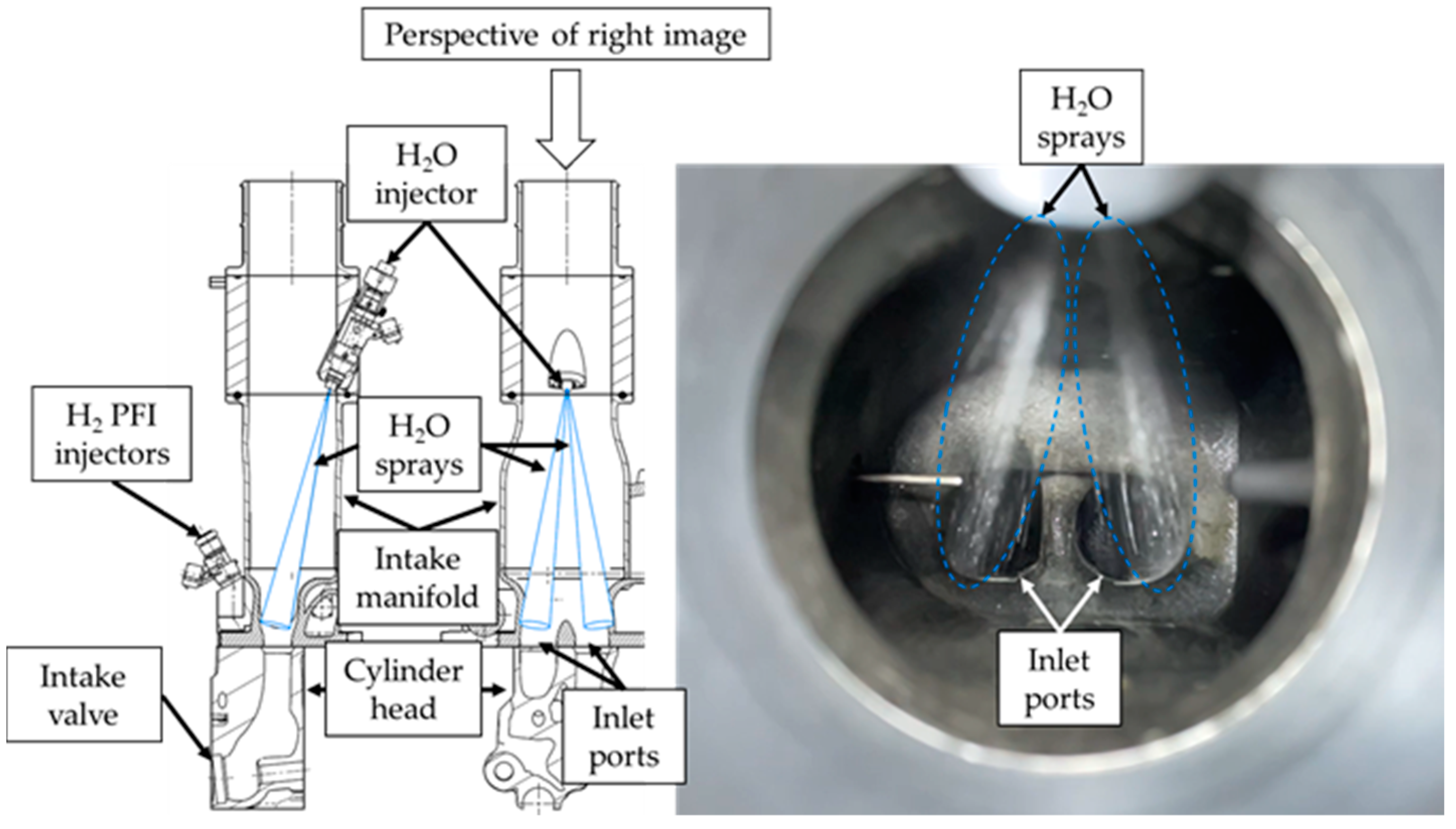
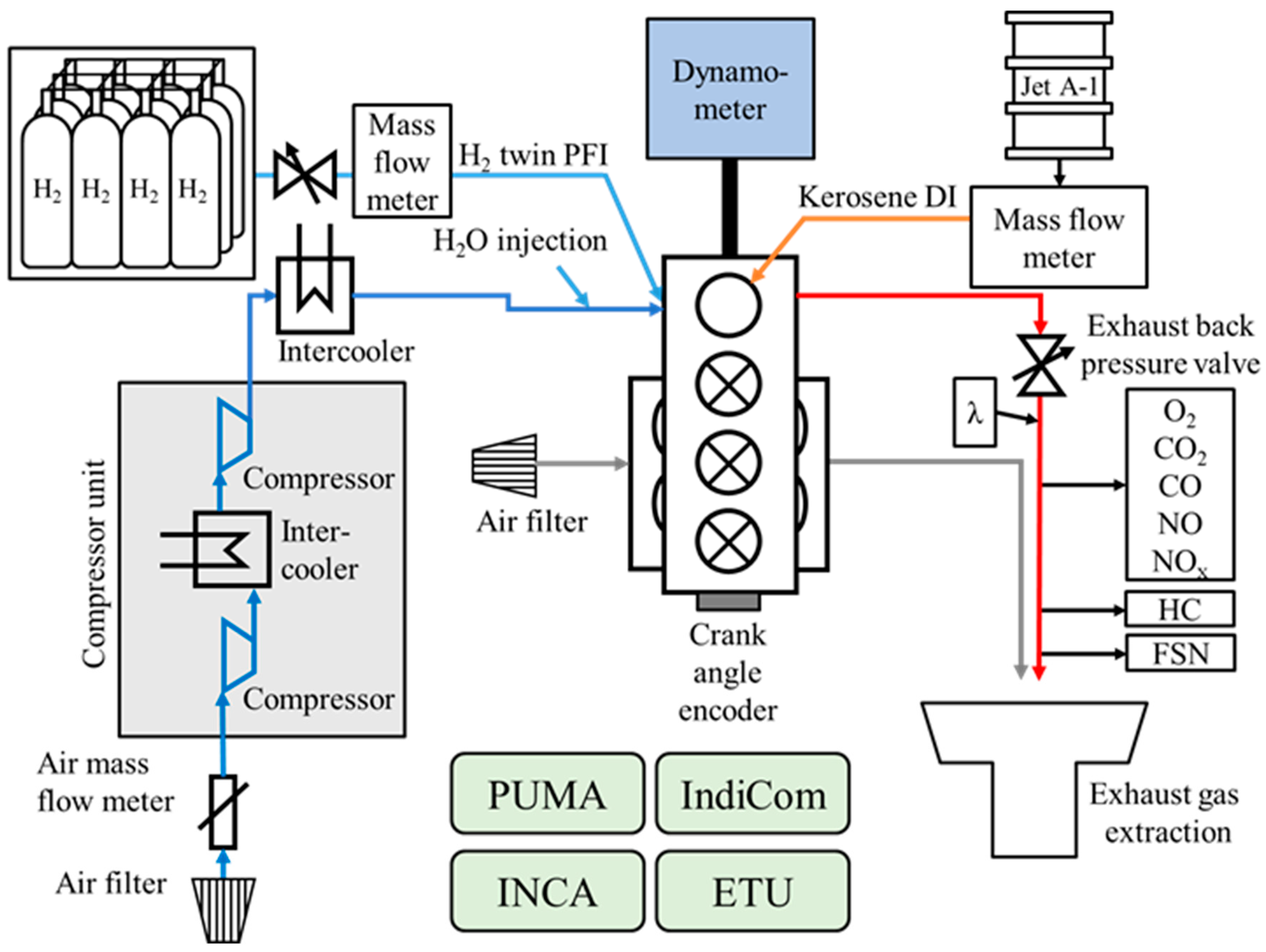
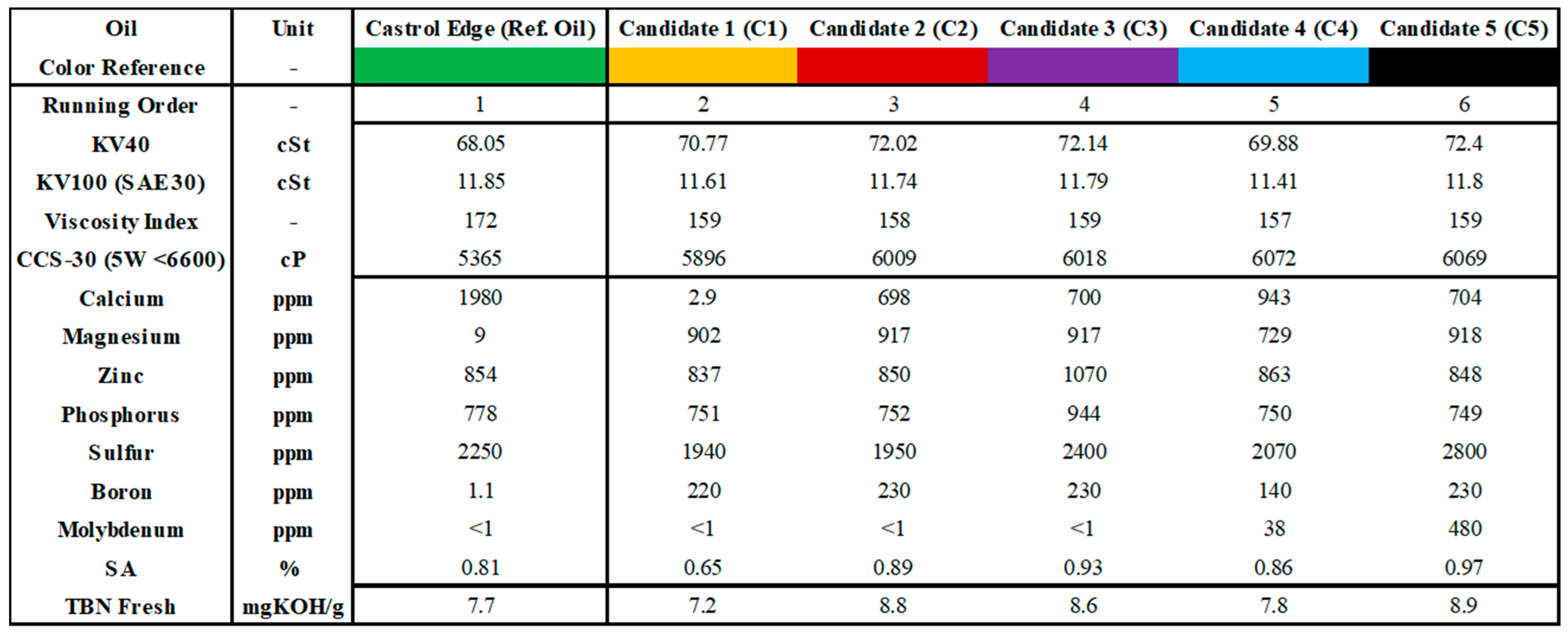
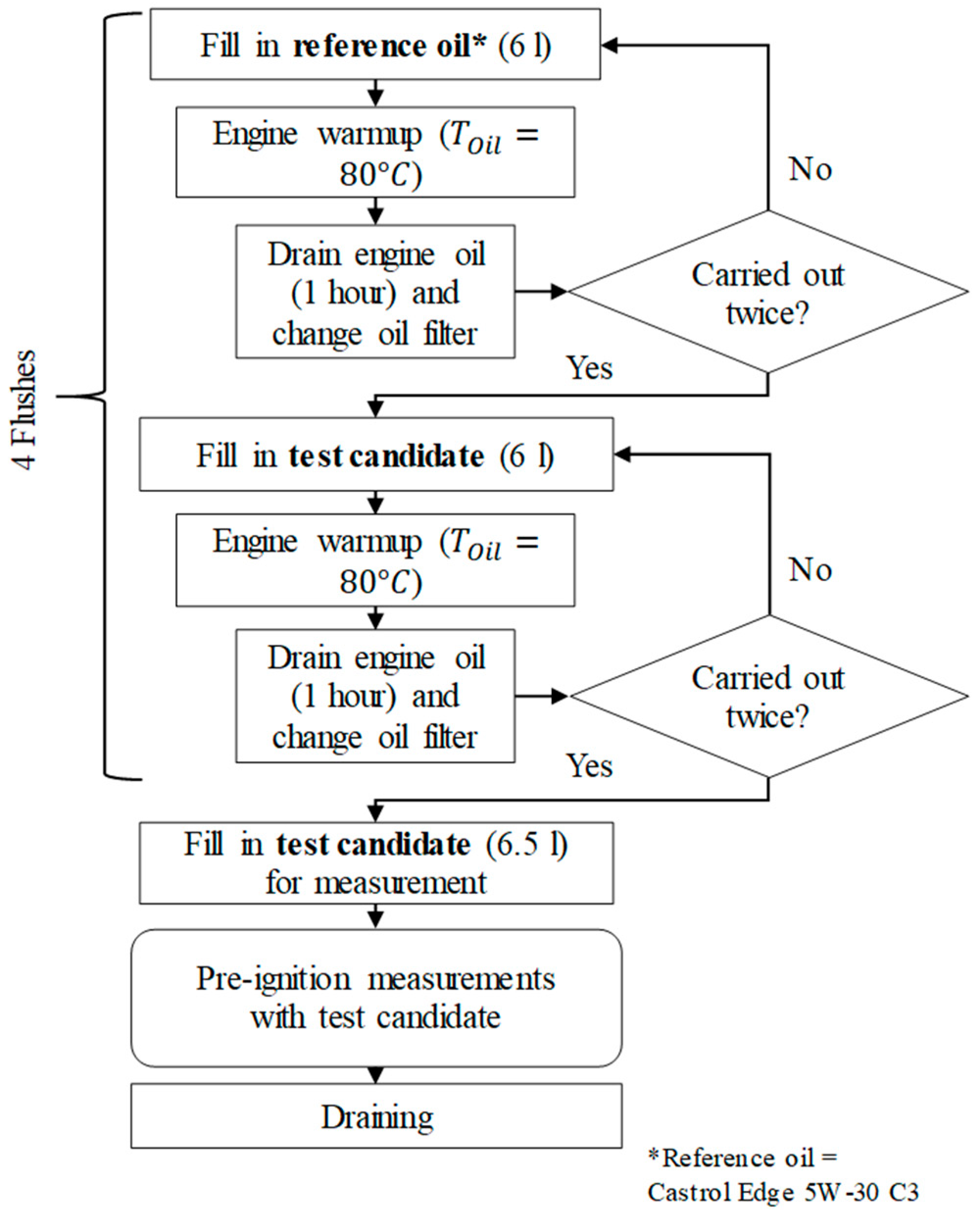
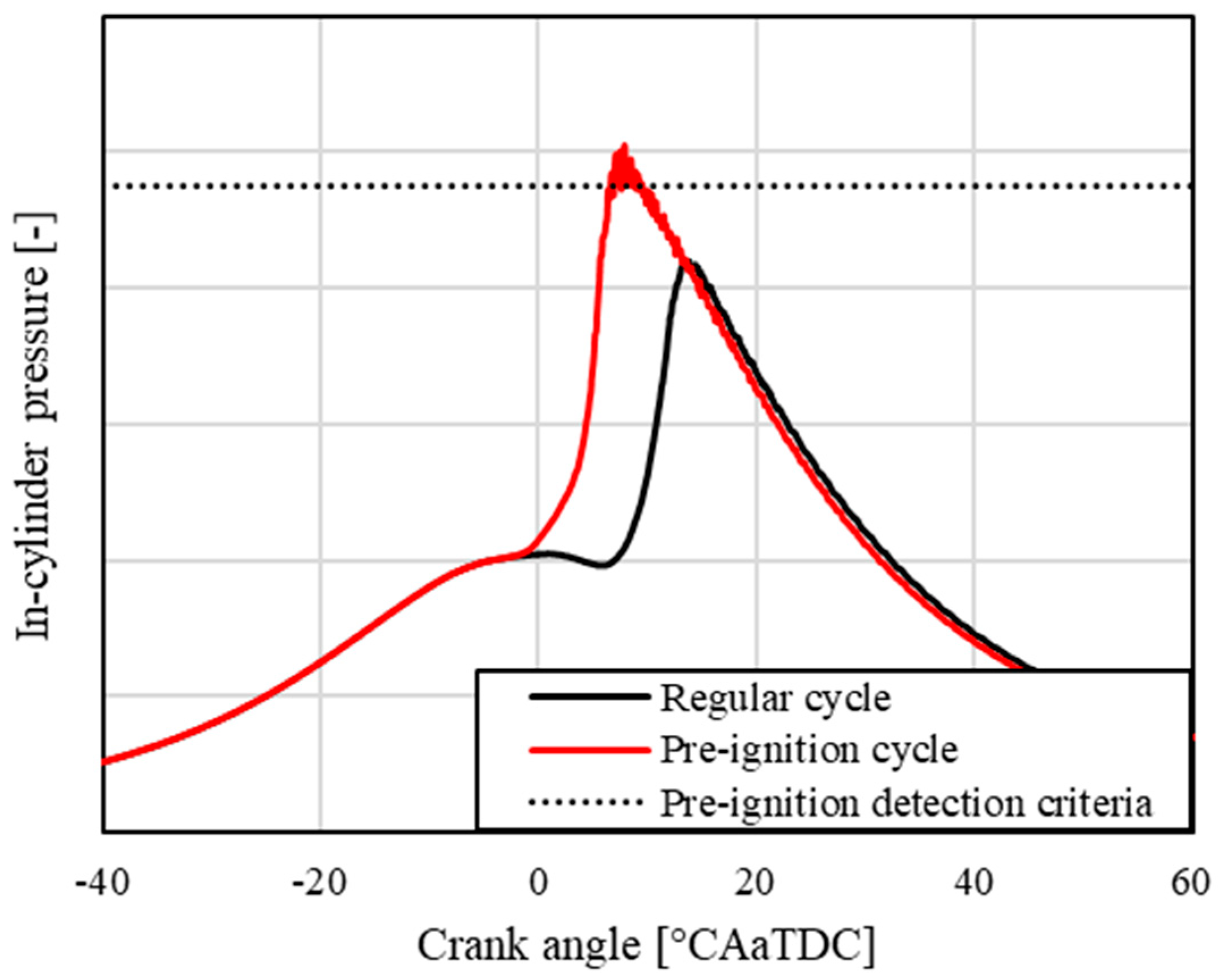
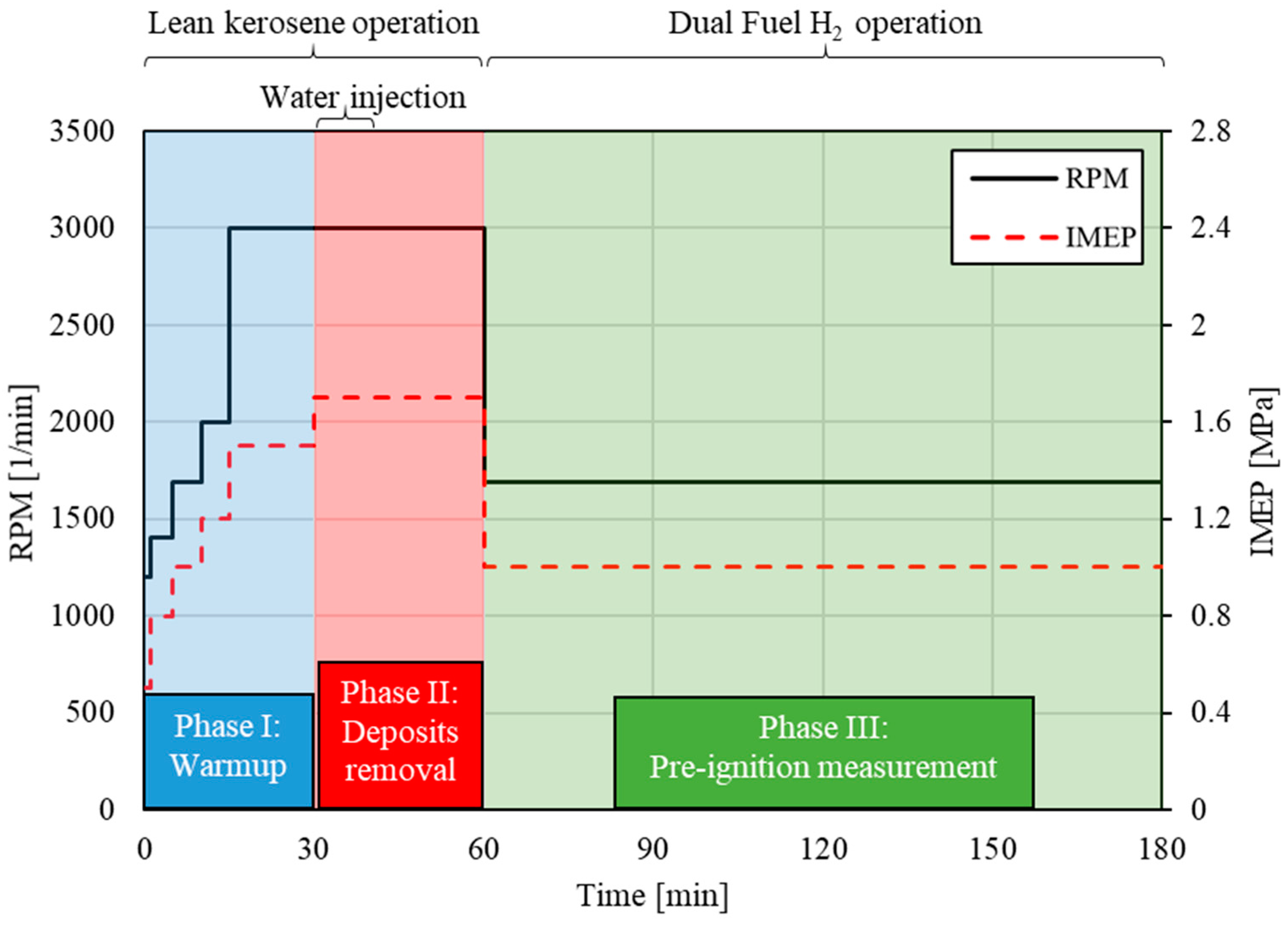
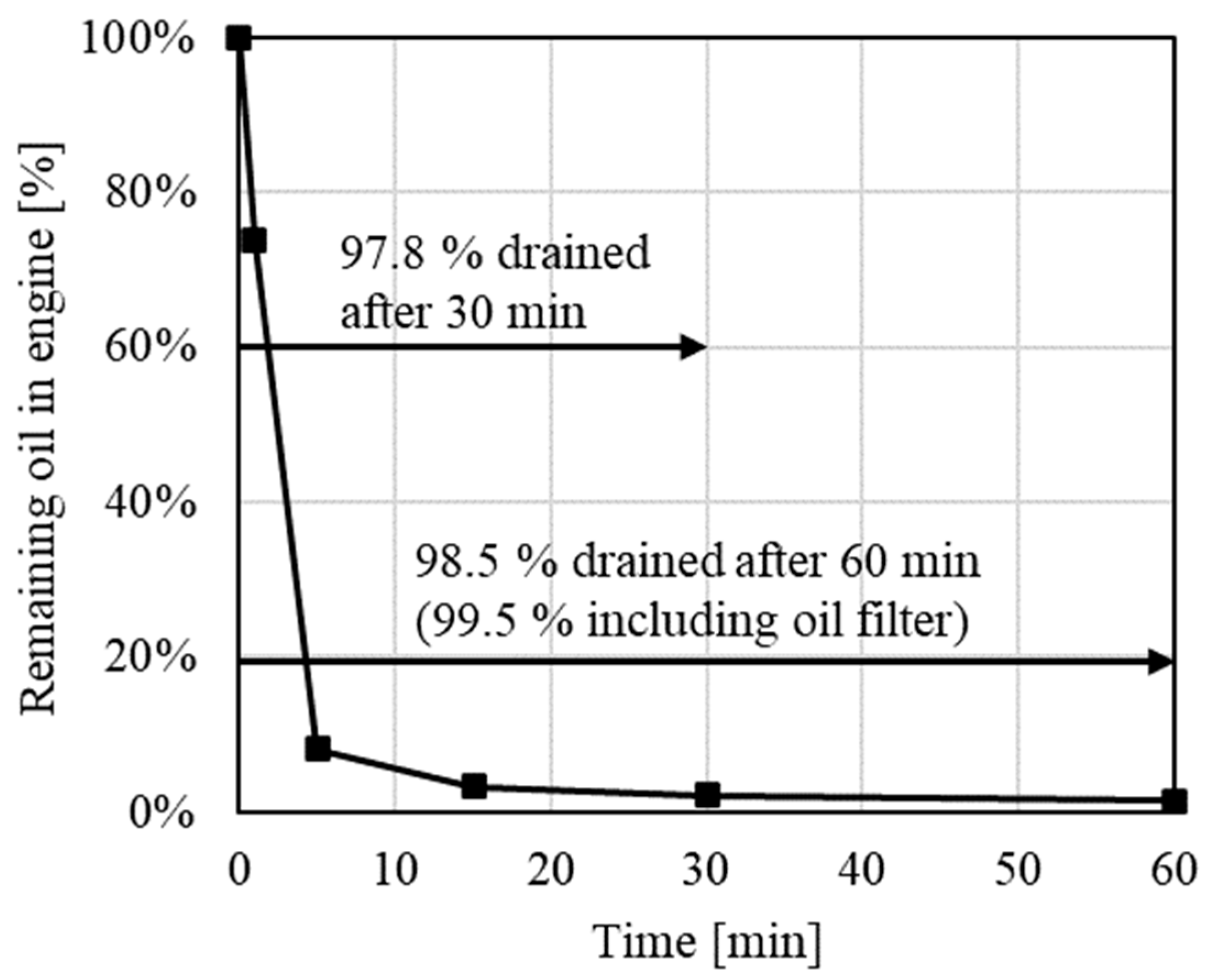
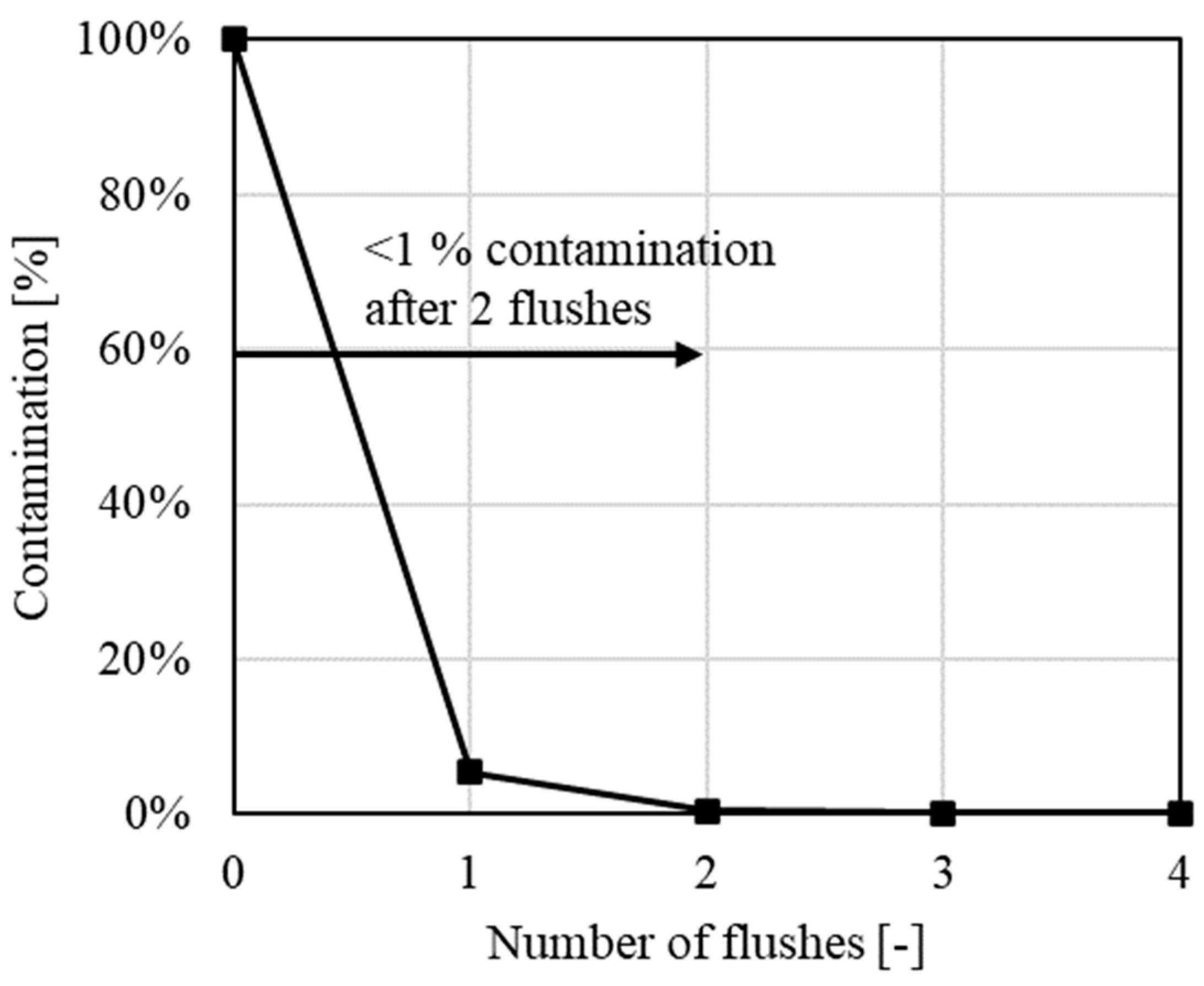

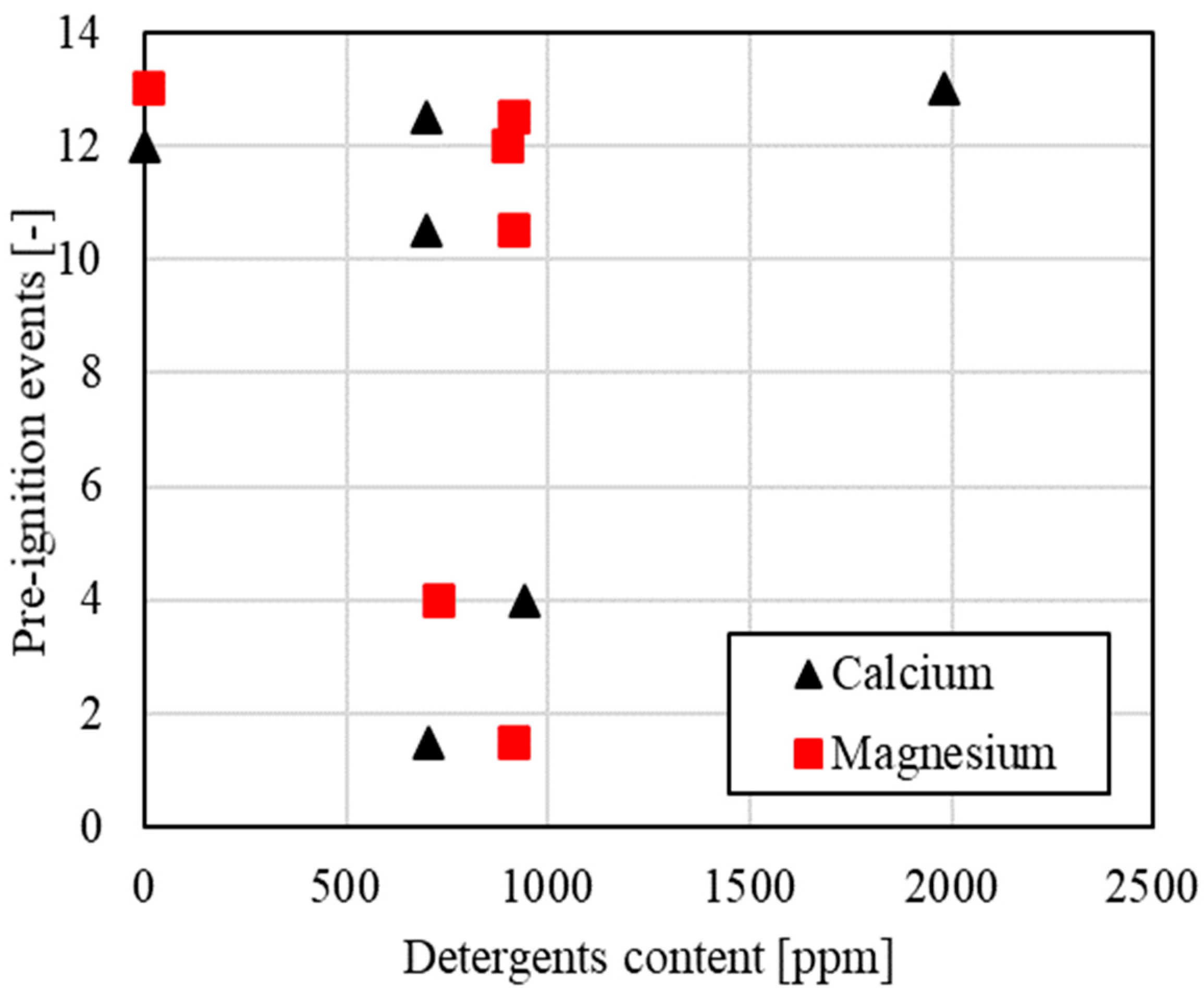
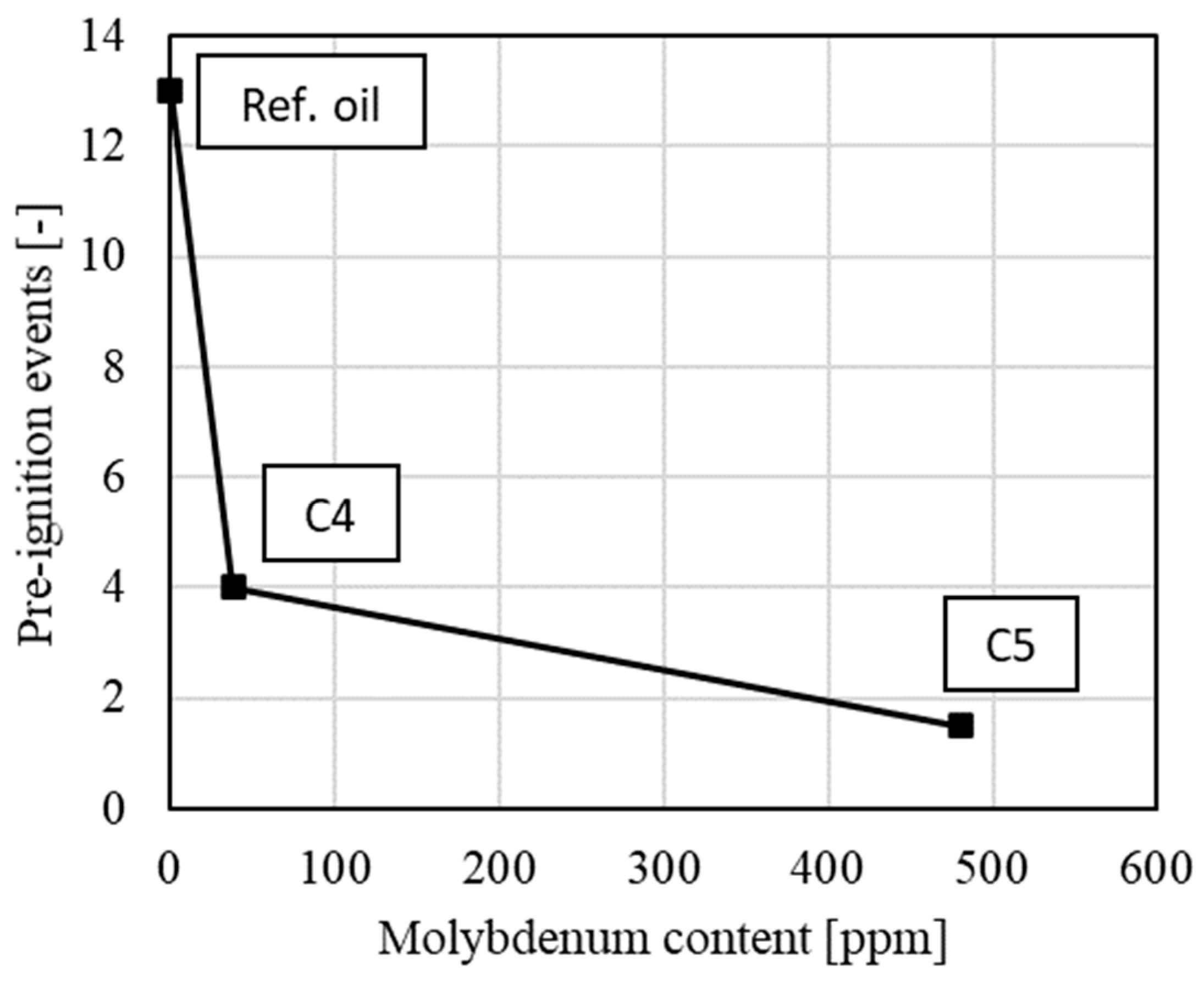
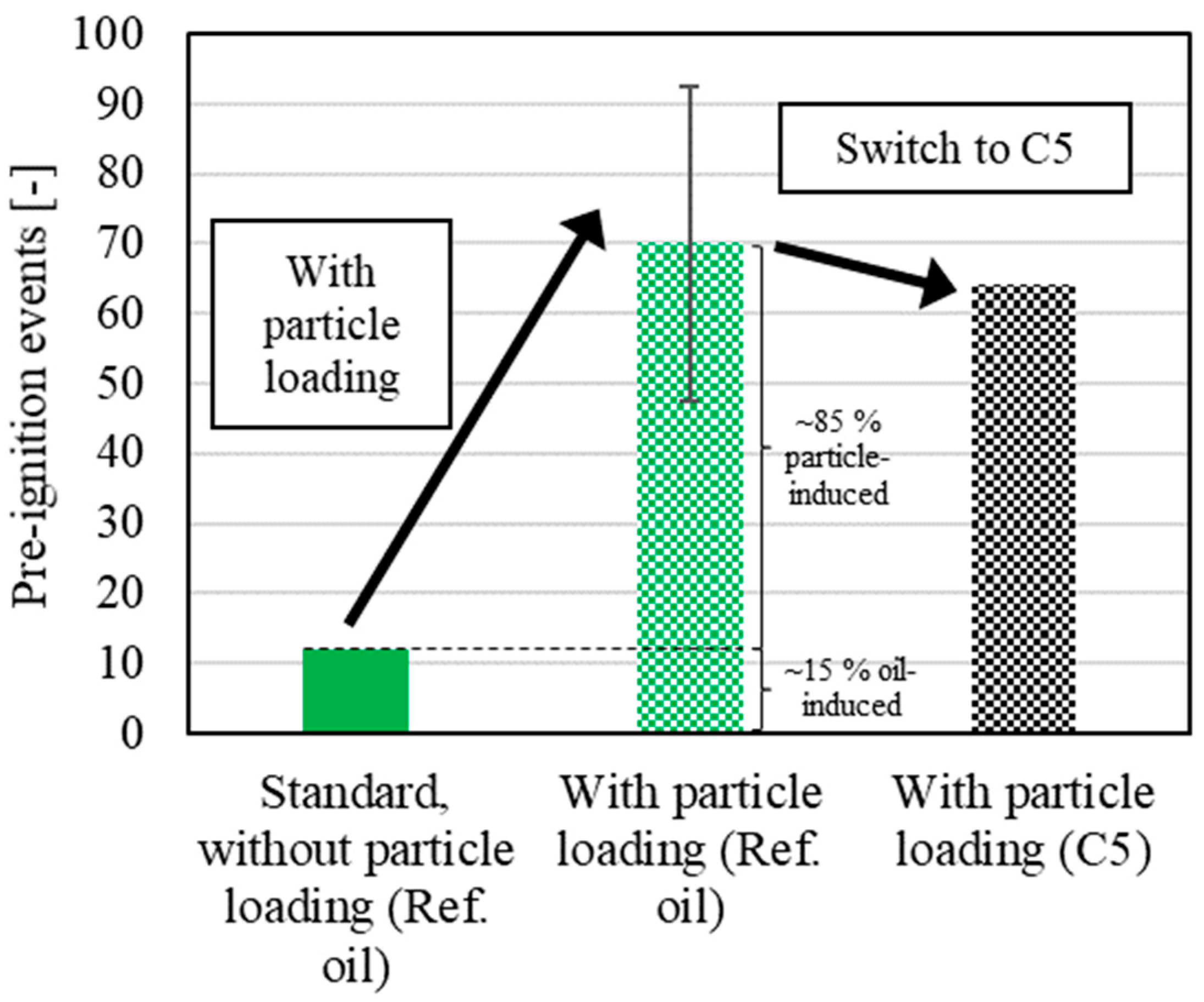
| Specification | Austro Engine AE330 |
|---|---|
| Max. Take-Off Power | 132 kW |
| Displacement | 1991 cm3 |
| Weight (dry) | 186 kg incl. gearbox |
| Fuel | Kerosene (Jet A-1) |
| Fuel Consumption | 39 l/h at 100% power |
| Fuel Consumption | 21 l/h at 60% power |
| Compression Ratio | 17.5:1 |
| Injection | Common Rail Direct Injection |
| Parameter | Unit | Diesel | Kerosene | Hydrogen (Gaseous) |
|---|---|---|---|---|
| Cetane number | - | 52–54 | 43 * | - |
| Density | kg/m3 | 820–845 | 775–840 | 0.09 |
| Lower heating value | MJ/kg | 42.9 | 43.26 | 120 |
| Stoichiometric air requirement | kgAir/kgFuel | 14.7 | 14.67 | 34.3 |
| Molar mass | g/mol | 190 | 167.3 | 2.016 |
| Minimum ignition energy | mJ | 0.24 | - | 0.017 |
| Ignition limits | λ-Range | 1.35–0.48 | - | 10–0.13 |
| Laminar flame speed | cm/s | 40 | - | 230 |
Disclaimer/Publisher’s Note: The statements, opinions and data contained in all publications are solely those of the individual author(s) and contributor(s) and not of MDPI and/or the editor(s). MDPI and/or the editor(s) disclaim responsibility for any injury to people or property resulting from any ideas, methods, instructions or products referred to in the content. |
© 2025 by the authors. Licensee MDPI, Basel, Switzerland. This article is an open access article distributed under the terms and conditions of the Creative Commons Attribution (CC BY) license (https://creativecommons.org/licenses/by/4.0/).
Share and Cite
Reitmayr, C.; Hofmann, P.; Howarth, P. Influence of Engine Oils on Pre-Ignition Tendency in a Hydrogen–Kerosene Dual-Fuel Engine. Lubricants 2025, 13, 126. https://doi.org/10.3390/lubricants13030126
Reitmayr C, Hofmann P, Howarth P. Influence of Engine Oils on Pre-Ignition Tendency in a Hydrogen–Kerosene Dual-Fuel Engine. Lubricants. 2025; 13(3):126. https://doi.org/10.3390/lubricants13030126
Chicago/Turabian StyleReitmayr, Christian, Peter Hofmann, and Paul Howarth. 2025. "Influence of Engine Oils on Pre-Ignition Tendency in a Hydrogen–Kerosene Dual-Fuel Engine" Lubricants 13, no. 3: 126. https://doi.org/10.3390/lubricants13030126
APA StyleReitmayr, C., Hofmann, P., & Howarth, P. (2025). Influence of Engine Oils on Pre-Ignition Tendency in a Hydrogen–Kerosene Dual-Fuel Engine. Lubricants, 13(3), 126. https://doi.org/10.3390/lubricants13030126




